IT-FR cooperation in Heritage Science
Diving into Digital Data for Heritage Science
Diagnostics, Underwater Heritage, and Sound
February 7th 2024 | Hybrid Event
H 9:00 AM - 1:30 PM (CET)
Within the framework of the Italian-French bilateral cooperation in Heritage Science, the seventh event will be focused on “Diving into Digital Data for Heritage Science: Diagnostics, Underwater Heritage, and Sound”.
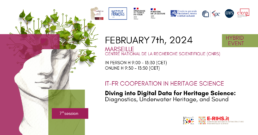
The hybrid event will take place on February 7th from 9:00 AM to 1:30 PM in Marseille at the Centre national de la recherche scientifique (CNRS), Joseph Aiguier Campus (31 chemin Joseph Aiguier) or online.
The event is hosted by colleagues of the Models and Simulations for Architecture and Heritage Laboratory of the Centre National de la Recherche Scientifique (MAP CNRS) and the Centre Interdisciplinaire de Conservation et de Restauration du Patrimoine (GIP CICRP Belle de Mai) in Marseille.
The event is the 7th edition of the events series promoted within the framework of the Italian-French bilateral cooperation in Heritage Science shaped following the Quirinal Treaty, thanks to collaboration among French and Italian promoters, such as the French Ministry of Culture and the Direzione Generale Educazione, ricerca e istituti culturali of Italian Ministry of Culture, the Istituto di Scienze del Patrimonio Culturale del Consiglio Nazionale delle Ricerche, the Fondation des Sciences du Patrimoine, the Institut Français Italia and the French Embassy in Italy.
We are excited to bring together experts from different fields to discuss the current context of cultural heritage in the green and digital transition.
Registration is open!
To ease the organisation of the seminar, for both in-person and online participation, you need to register for the event.
Please remember that registration will be open until the 1st of February.
We look forward to seeing you on February 7th!
Presentations by speakers at the event are available here
Diving into Digital Data for Heritage Science
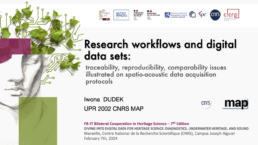
Research workflows and digital data sets:
traceability, reproducibility, comparability issues illustrated on spatio-acoustic data acquisition protocols
In this presentation, we discuss the importance of traceability, verifiability and comparability of research workflows and digital data sets. We highlight the challenges associated with the choice of language, which can affect the interpretation of research descriptions. To address this, we propose the use of conceptual modelling, controlled vocabulary and diagrammatic representations as a means of reducing interpretation variability. These elements form the basis on which the MEMORIA exploratory information system is built. The main objectives of the system, notably the identification and preservation of information on different types of research results and the sequences of actions that led to their creation, are illustrated using spatio-acoustic data acquisition protocols. We conclude by mentioning the constraints and limitations of the system, including the reliability of the data and the time-consuming nature of the documentation.
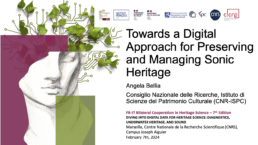
Towards a Digital Approach for Preserving and Managing Sonic Heritage.
Ancient theatres are spread across a large territory that covers three continents. The international community has urged the commitment to preserve ancient theatres from the ravages of time and the action of human beings: given that disastrous natural events, climate changes, pollution and/or improper uses of these buildings are progressively damaging these architectural structures and their sonic heritage, effective preservation planning policy based on the prevention and mitigation of vulnerabilities and dangers is vital, especially in ancient theatres are now used as locations for concerts and modern performances. The survey on the sonic heritage of these ancient spaces for performances can enhance our knowledge of the acoustic design of theatre buildings obtained through 3D virtual reconstructions and the creation of acoustic models, taking in consideration the philological reading of the original system and the theoretical verification of the available archaeological data. Performing analysis on the best sound effects in ancient theatres can help significantly in establishing more precisely the nexus sound-in-space in performative spaces. Moreover, the assessment of the risk of sonic heritage in theatrical spaces and the relationship with their intangible aspects can enhance our knowledge on their transformation from generic or conventional built structures to buildings that can amplify the active sound properties of architecture. The development of a new multidisciplinary analytical approach that models the relationship between the intangible aspects and the spatial configuration of ancient theatrical structures can contribute to their future protection and preservation and their modern reuse.
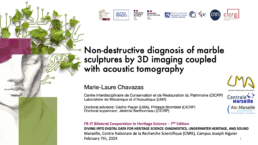
Non-destructive diagnosis of marble sculptures by 3D imaging coupled with acoustic tomography
Evaluating the internal deterioration state of cultural heritage artefacts is of foremost importance to propose adequate conservation and restoration. Studying these particular objects implies some requirements: techniques used for diagnosis must not damage the object. Ultrasonic methods can be an adequate solution as they are non-destructive. In this work, acoustic tomography is performed on a marble altar to produce a cartography of ultrasonic pulse velocity inside the object. Because of the complex geometry of the altar, distances between emitters and receivers are calculated on a photogrammetric 3D model. Ultrasonic pulse velocity values can highlight the internal homogeneity or heterogeneity of the object, its zones of weakness, its cracks, etc.
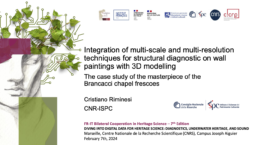
Integration of multi-scale and multi-resolution techniques for structural diagnostic on wall paintings with 3D modelling.
The case study of the masterpiece of the Brancacci chapel frescoes
The paper discusses the use of complementary non-destructive techniques based on optical and electromagnetic methods for the characterization of the structural integrity of the wall paintings and their support. The test site are the renaissance wall paintings by Masaccio, Masolino, and Filippino Lippi in the Brancacci chapel in Firenze.
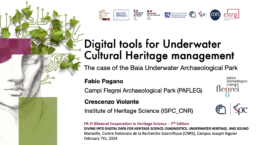
Digital tools for underwater cultural heritage management. The case of the Campi Flegrei Archaeological Park
The Archaeological Park of Campi Flegrei (PAFLEG) is one of the autonomous institutions created within the most recent reform of the Italian Ministry of Culture. It embraces twenty-five separated sites located north of Naples, including the oldest Greek colony in the Western Mediterranean, Cumae, and one of the major centres of ancient Rome’s economic and military power, Puteoli, with its port. The PAFLEG is located in an active volcanic area characterized by vertical ground movements called “bradyseism”. Consequently, architectural remains including villae maritimae with their marble and mosaic decoration, and landing ports are now submerged up to a depth of ca. -10 m b.s.l. in the Underwater Park of Baiae. Here several actions are being implemented for the digitalization of the Underwater Cultural Heritage (UCH). Innovative scientific analysis methods and most recent technological advances and developments in marine digital technologies, enables non-invasive documentation, analysis, and monitoring of UCH, with unprecedented precision and sensitivity, contributing to its knowledge and preservation. Such approach is now crucial to develop strategies for conservation of marine cultural heritage, and for a number of policy and management issues.
Further information
The event is seventh of a series of seminars.
- The first event held in Rome on September 15th, 2022
- The second event held online on November 10th, 2023
- The third event held in Paris on January 27th, 2023
- The fourth event held online on April 27th, 2023
- The fifth event held in Naples on June 28th, 2023
- The sixth event held online on October 19th 2023
For further information about previous events, we invite you to visit the pages dedicated to the Italian-French partnership for heritage science.
